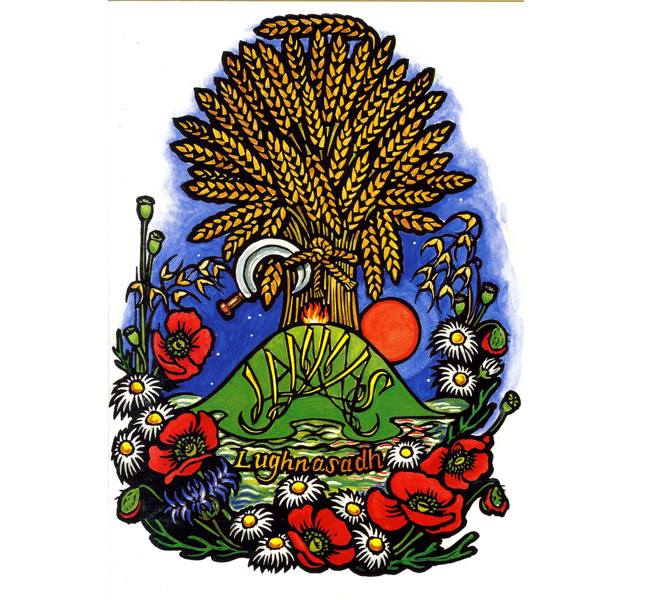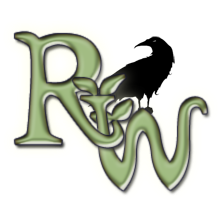Other Names: Lammas, Lughnasad, Lugnassad, Lunasa
Date: August 1 (Greater Sabbat/Cross Quarter)
Celebration of: A Festival of not only life and bounty, but of harvest and death, the complete cycle of life.
Colors: Gold and Bright Yellow
Symbols: Summer flowers, nuts and grains
Notes: Fire and light festival. First grain harvest. Feast dedicated to Earth Mother. Count your blessings.
LUGHNASADH, (say Loo-Nah-Suh, or Lah-Mass) the Festival of Sacrifice (also known as LAMMAS) is the first of the three Celtic harvest festivals; the grain (or corn) harvest. The union of the God and Goddess gave birth to the bounty of the earth. This is a time of great joy but no longer is the God the virile groom of Beltane nor the Goddess the young Bride. Now He is in the Autumn
of life and She the Great Mother who uses Her power to bring forth a bountiful harvest. Now is the time that we, too, reap the harvest our our own seeds that were sown at Imbolc. The God personifies the the Spirit of Nature that dies each Autumn, while the Goddess is the principle of Eternal Life. Now the God is the Spirit of the Grain; willingly cut down, he is a sacrifice for the sake of the living. His spirit descends into the Earth, the womb of the Goddess, waiting to be reborn at Yule. This is a bitter-sweet time. Death is incomprehensible but the God and Goddess speak to parts of us that are deeper and higher, helping us to feel peaceful and in harmony with this eternal process. Sacred symbols include the making of a corn wheel and the corn dolly, wheat, the loaf.
The First Harvest
by Mike Nichols
http://www.witchessabbats.com/
"It was upon a Lammas Night
When corn rigs are bonny,
Beneath the Moon's unclouded light,
I held awhile to Annie….
Although in the heat of a midwestern summer it might be difficult to discern, the festival of Lammas (August 1) marks the end of summer and the beginning of fall. The days now grow visibly shorter and by the time we’ve reached autumn’s end (October 31), we will have run the gamut of temperature from the heat of August to the cold and (sometimes) snow of November. And in the midst of it, a perfect midwestern autumn.
The history of Lammas is as convoluted as all the rest of the old folk holidays. It is, of course, a cross-quarter day, one of the four High Holidays or Greater Sabbats of Witchcraft, occurring one quarter of a year after Beltane. Its true astrological point is fifteen degrees Leo, but tradition has set August 1 as the day Lammas is typically celebrated. The celebration proper would begin on sundown of the previous evening, our July 31, since the Celts reckon their days from sundown to sundown.
However, British Witches often refer to the astrological date of August 6 as Old Lammas, and folklorists call it Lammas O.S. (Old Style). This date has long been considered a “power point” of the zodiac, and is symbolized by the Lion, one of the tetramorph figures found on the tarot cards, the World and the Wheel of Fortune (the other three figures being the Bull, the Eagle, and the Spirit). Astrologers know these four figures as the symbols of the four “fixed” signs of the zodiac, and these naturally align with the four Great Sabbats of Witchcraft. Christians have adopted the same iconography to represent the four Gospel writers.
“Lammas” was the medieval Christian name for the holiday, and it means “loaf-mass”, for this was the day on which loaves of bread were baked from the first grain harvest and laid on the church altars as offerings. It was a day representative of “first fruits” and early harvest.
In Irish Gaelic, the feast was referred to as “Lughnasadh”, a feast to commemorate the funeral games of the Irish Sun God Lugh. However, there is some confusion on this point. Although at first glance, it may seem that we are celebrating the death of Lugh, the God of Light does not really die (mythically) until the autumnal equinox. And indeed, if we read the Irish myths closer, we discover that it is not Lugh’s death that is being celebrated, but the funeral games that Lugh hosted to commemorate the death of his foster mother, Taillte. That is why the Lughnasadh celebrations in Ireland are often called the “Tailltean games”.
The time went by with careless heed
Between the late and early,
With small persuasion she agreed
To see me through the barley….
One common feature of the games was the “Tailltean marriages”, a rather informal marriage that lasted for only a year-and-a-day or until next Lammas. At that time, the couple could decide to continue the arrangement if it pleased them, or to stand back to back and walk away from one another, thus bringing the Tailltean marriage to a formal close. Such trial marriages (obviously related to the Wiccan handfasting) were quite common even into the 1500s, although it was something one “didn’t bother the parish priest about”. Indeed, such ceremonies were usually solemnized by a poet, bard, or shanachie (or, it may be guessed, by a priest or priestess of the Old Religion).
Lammastide was also the traditional time of year for craft festivals. The medieval guilds would create elaborate displays of their wares, decorating their shops and themselves in bright colors and ribbons, marching in parades, and performing strange, ceremonial plays and dances for the entranced onlookers. The atmosphere must have been quite similar to our modern-day Renaissance festivals.
A ceremonial highlight of such festivals was the Catherine wheel. Although the Roman Church moved St. Catherine’s feast day all around the calendar with bewildering frequency, its most popular date was Lammas. (They also kept trying to expel this much-loved saint from the ranks of the blessed because she was mythical rather than historical, and because her worship gave rise to the heretical sect known as the Cathari.) At any rate, a large wagon wheel was taken to the top of a nearby hill, covered with tar, set aflame, and ceremoniously rolled down the hill. Some mythologists see in this ritual the remnants of a Pagan rite symbolizing the end of summer, the flaming disk representing the Sun God in his decline. And just as the Sun King has now reached the autumn of his years, his rival or dark self has just reached puberty.
Many commentators have bewailed the fact that traditional Gardnerian and Alexandrian Books of Shadows say very little about the holiday of Lammas, stating only that poles should be ridden and a circle dance performed. This seems strange, for Lammas is a holiday of rich mythic and cultural associations, providing endless resources for liturgical celebration.
Corn rigs and barley rigs,
Corn rigs are bonny!
I'll not forget that happy night
Among the rigs with Annie!
[Verse quotations by Robert Burns, as handed down through several Books of Shadows.]
Document Copyright © 1983 – 2009 by Mike Nichols.
Text editing courtesy of Acorn Guild Press.
Website redesign by Bengalhome Internet Services, © 2009
Permission is given to re-publish this document only as long as no information is lost or changed, credit is given to the author, and it is provided or used without cost to others.
This notice represents an exception to the copyright notice found in theAcorn Guild Press edition of The Witches' Sabbats and applies only to the text as given above.
Other uses of this document must be approved in writing by Mike Nichols.


